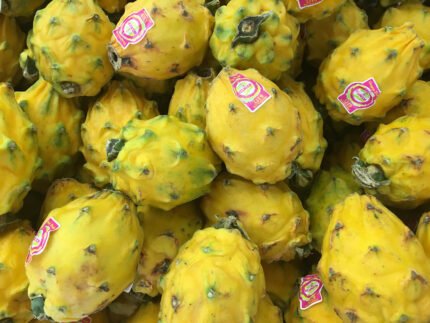Medically reviewed by Dr. Ramesh Gaddam, M.D. — Written by Sumalatha, D.N.H.E
Yellow dragon fruit, also known as yellow pitaya or pitahaya, is a tropical fruit with bright yellow skin and white or yellowish flesh speckled with small black seeds that belongs to the cactus family (Cactaceae). Rich in vitamin C, fiber, and antioxidants, it offers a sweet, mildly tangy taste. Enjoyed fresh or in various dishes, it promotes immune health and aids digestion.
The scientific name for the yellow dragon fruit is Selenicereus megalanthus. It is native to Central and South America but is now cultivated in various parts of the world, including Southeast Asia.
Yellow Dragon Fruit Nutrition
Nutritional facts of yellow dragon fruit per 100 grams:
| Nutrient | Amount |
|---|---|
| Calories | 60 |
| Water | 90% |
| Protein | 1.2 grams |
| Carbohydrates | 13.1 grams |
| Dietary Fiber | 3 grams |
| Sugars | 8 grams |
| Fat | 0.4 grams |
| Vitamin C | 9.0 mg (15% DV) |
| Calcium | 9 mg (1% DV) |
| Iron | 0.9 mg (5% DV) |
| Magnesium | 18 mg (5% DV) |
| Phosphorus | 27 mg (3% DV) |
| Potassium | 183 mg (5% DV) |
Yellow Dragon Fruit Benefits
Yellow dragon fruit, like its red counterpart, offers various health benefits due to its nutrient-rich profile.

Here are some potential health benefits associated with consuming yellow dragon fruit:
Rich in Antioxidants:
Yellow dragon fruit contains antioxidants, such as vitamin C and other phytonutrients, which help combat oxidative stress in the body.
Antioxidants play a role in neutralizing free radicals and may contribute to overall health.
Supports Immune Function:
The high vitamin C content in yellow dragon fruit is beneficial for the immune system.
Vitamin C is known to stimulate the production of white blood cells, boost immune response, and protect against infections and illnesses.
Promotes Healthy Skin:
The combination of vitamins and antioxidants in yellow dragon fruit may contribute to healthier skin.
Vitamin C is essential for collagen synthesis, which is important for skin elasticity and the prevention of signs of aging.
Aids in Digestion:
The dietary fiber in yellow dragon fruit promotes digestive health.
Fiber adds bulk to the stool, helps prevent constipation, and supports a healthy digestive system.
May Help Regulate Blood Sugar Levels:
The fiber content, coupled with the relatively low sugar content in dragon fruit, may contribute to better blood sugar control.
However, individuals with diabetes should still monitor their intake and consult with a healthcare professional.
Provides Hydration:
Yellow dragon fruit has a high water content, which can contribute to overall hydration.
Staying hydrated is essential for various bodily functions, including digestion, temperature regulation, and nutrient transport.
Source of Essential Nutrients:
Yellow dragon fruit is a good source of essential nutrients, including vitamins (C, B vitamins), minerals (iron, magnesium, phosphorus, potassium), and dietary fiber.
These nutrients play crucial roles in various physiological processes.
May Have Anti-Inflammatory Properties:
Some studies suggest that the antioxidants in dragon fruit may have anti-inflammatory effects, which could be beneficial for reducing inflammation in the body.
Calories of Yellow Dragon Fruit
The calorie content of yellow dragon fruit is relatively low, making it a nutritious and low-calorie addition to your diet.

On average, yellow dragon fruit contains about 60 calories per 100 grams.
Actual calorie content may vary slightly based on factors such as the specific variety of yellow dragon fruit and growing conditions.
This low-calorie fruit is not only a tasty and refreshing snack but also provides various essential nutrients, including vitamin C, dietary fiber, and various minerals. Incorporating yellow dragon fruit into a balanced diet can contribute to overall health and well-being.
Fiber in Yellow Dragon Fruit
Yellow dragon fruit is a good source of dietary fiber, which is beneficial for digestive health. On average, yellow dragon fruit contains about 3 grams of dietary fiber per 100 grams. However,
the exact fiber content can vary slightly depending on factors such as the specific variety of yellow dragon fruit and growing conditions.
Dietary fiber is important for various aspects of health, including promoting regular bowel movements, preventing constipation, and supporting a healthy digestive system.
Additionally, fiber can contribute to a feeling of fullness, which may be helpful for those looking to manage their weight.
Incorporating yellow dragon fruit into your diet is a delicious way to increase your fiber intake along with other essential nutrients.
Yellow Dragon Fruit Side Effects
Yellow dragon fruit is generally considered safe for most people when consumed in moderation as part of a balanced diet. However, there are a few considerations and potential side effects to be aware of:

Allergies:
While rare, some individuals may be allergic to certain fruits, including dragon fruit.
If you experience symptoms such as itching, swelling, or difficulty breathing after consuming yellow dragon fruit, seek medical attention immediately.
Gastrointestinal Issues:
The high fiber content in dragon fruit can lead to gastrointestinal discomfort for some people, especially if they are not accustomed to consuming a lot of fiber.
Eating excessive amounts of dragon fruit may cause bloating, gas, or diarrhea.
It’s advisable to introduce fiber-rich foods gradually into your diet to allow your digestive system to adjust.
Interactions with Medications:
If you are taking medications or have specific health conditions, it’s always a good idea to check with your healthcare provider before making significant changes to your diet.
Some compounds in fruits, including dragon fruit, might interact with certain medications.
Natural Laxative Effect:
The fiber content in dragon fruit may act as a natural laxative for some individuals.
While this can be beneficial for preventing constipation, it’s important not to overconsume, as it may lead to loose stools or diarrhea.
Oxalates:
Dragon fruit contains oxalates, which are compounds that can contribute to the formation of kidney stones in susceptible individuals.
If you have a history of kidney stones or are at risk, it’s advisable to moderate your intake of high-oxalate foods.
Sugar Content:
While relatively low in sugar compared to some other fruits, dragon fruit still contains natural sugars.
Individuals with diabetes or those monitoring their sugar intake should be mindful of their consumption.
How to eat yellow dragon fruit?
Eating yellow dragon fruit is a simple and enjoyable experience. Here are steps to guide you on how to eat yellow dragon fruit:
Selecting a Ripe Fruit:
Choose a yellow dragon fruit with vibrant yellow skin.
The fruit should have a slight give when gently pressed, similar to the texture of a ripe avocado.
Avoid fruits with overly brown or shriveled skin, as they may be overripe.
Washing the Fruit:
Rinse the dragon fruit under cool, running water to remove any dirt or debris.
Cutting the Dragon Fruit:
Place the fruit on a cutting board. Using a sharp knife, cut off both ends of the dragon fruit.
Stand the fruit upright on one of the cut ends and carefully slice off the skin, following the curve of the fruit.
Preparing the Flesh:
Once the skin is removed, you’ll be left with the flesh of the dragon fruit. Cut the flesh into slices, cubes, or chunks, depending on your preference.
Serving:
Serve the yellow dragon fruit as is, or combine it with other fruits to create a colorful fruit salad.
You can also add dragon fruit to smoothies, yogurt, or desserts for extra flavor and texture.
Enjoying the Seeds:
The fruit contains small, edible black seeds. These seeds are often crunchy and add a subtle nutty flavor to the fruit.
You can eat the seeds along with the flesh or choose to spit them out if you prefer.
Creative Recipes:
Get creative with how you enjoy yellow dragon fruit. Incorporate it into recipes for fruit salsa, sorbet, or even use it as a topping for pancakes or waffles.
Taste of Yellow Dragon Fruit
The taste of yellow dragon fruit is often described as sweet and mildly tangy. It has a subtly sweet flavor profile, with hints of tropical and floral notes.
The texture of the flesh is crisp and refreshing, similar to a cross between a kiwi and a pear.
The fruit’s taste is not overpowering, making it a versatile ingredient that pairs well with various other fruits and can be used in both sweet and savory dishes.
The seeds in the yellow dragon fruit are edible and add a slight crunch, reminiscent of the texture found in kiwi fruit.
Some people find the seeds enhance the overall eating experience, while others may prefer to spit them out.
Overall, the taste of yellow dragon fruit makes it a popular choice for fresh consumption, as well as a delightful addition to fruit salads, smoothies, desserts, and other culinary creations.
Its vibrant color, unique appearance, and pleasant flavor contribute to its popularity as a visually appealing and tasty tropical fruit.
Medically reviewed by Dr. Ramesh Gaddam, M.D.

General Physician, Diabetologist, and Critical Care Specialist.
Discover more from Health Build-Up
Subscribe to get the latest posts sent to your email.
